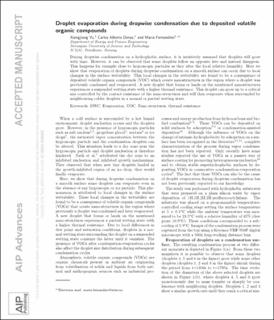Droplet evaporation during dropwise condensation due to deposited volatile organic compounds
Peer reviewed, Journal article
Accepted version

Åpne
Permanent lenke
https://hdl.handle.net/11250/2779259Utgivelsesdato
2021Metadata
Vis full innførselSamlinger
Originalversjon
10.1063/5.0056005Sammendrag
During dropwise condensation on a hydrophobic surface, it is intuitively assumed that droplets will grow with time. However, it can be observed that some droplets follow an opposite fate and instead disappear. This happens, for example, close to hygroscopic particles as they alter the local relative humidity. Here, we show that evaporation of droplets during dropwise condensation on a smooth surface can occur due to local changes in the surface wettability. These local changes in the wettability are found to be a consequence of deposited volatile organic compounds that create nanostructures in the region where a droplet was previously condensed and evaporated. A new droplet that forms or lands on the mentioned nanostructures experiences a suspended wetting state with a higher thermal resistance. This droplet can grow up to a critical size controlled by the contact resistance of the nano-structures and will then evaporate when surrounded by neighboring colder droplets in a normal or partial wetting state.